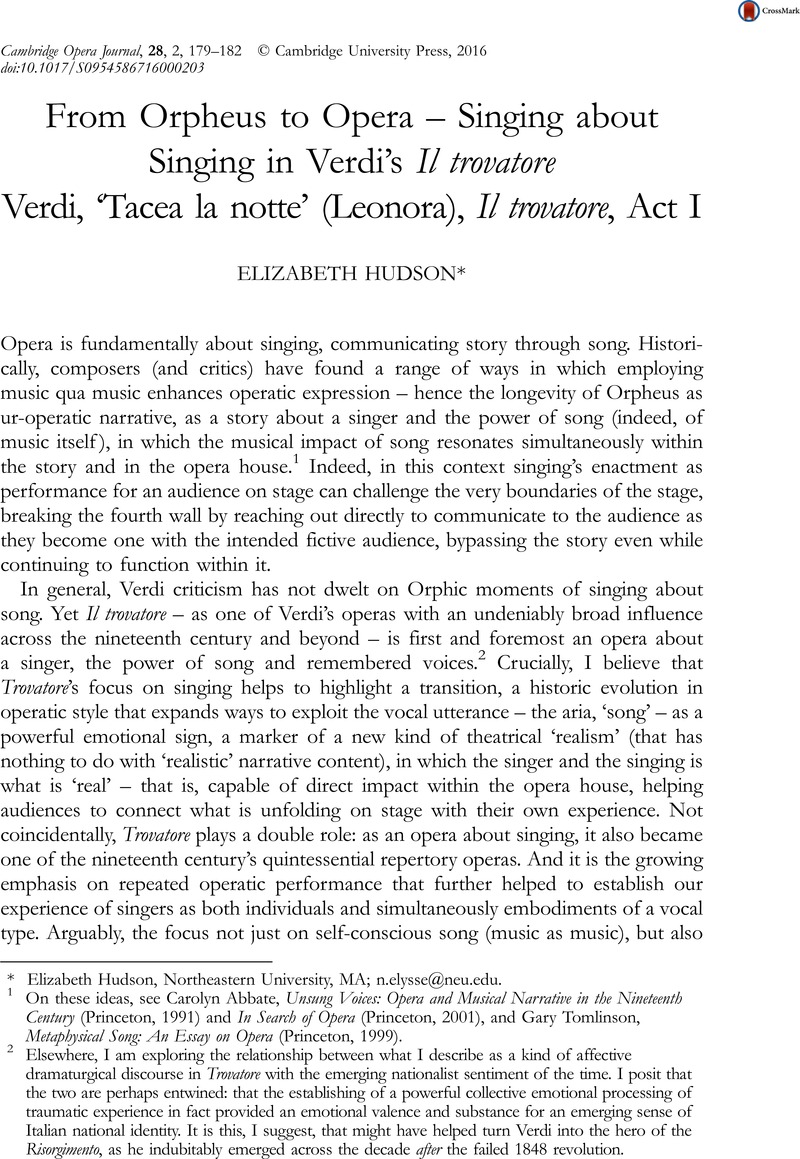Published online by Cambridge University Press: 28 September 2016

Elizabeth Hudson, Northeastern University, MA; [email protected].
1 On these ideas, see Abbate, Carolyn, Unsung Voices: Opera and Musical Narrative in the Nineteenth Century (Princeton, 1991)CrossRefGoogle Scholar and In Search of Opera (Princeton, 2001), and Tomlinson, Gary, Metaphysical Song: An Essay on Opera (Princeton, 1999)CrossRefGoogle Scholar.
2 Elsewhere, I am exploring the relationship between what I describe as a kind of affective dramaturgical discourse in Trovatore with the emerging nationalist sentiment of the time. I posit that the two are perhaps entwined: that the establishing of a powerful collective emotional processing of traumatic experience in fact provided an emotional valence and substance for an emerging sense of Italian national identity. It is this, I suggest, that might have helped turn Verdi into the hero of the Risorgimento, as he indubitably emerged across the decade after the failed 1848 revolution.
3 While there is of course a long history of vocal types, the settling of these vocal stereotypes into the Fach system, as a way of managing singers’ casting in operas and eventually acting to police and control the relationship of individual voices to operatic texts, escalated with the consolidation of a core repertory opera – a consolidation that arguably started to settle around works such as Verdi’s Rigoletto and Trovatore.
4 To see a detailed reading of how triggering the spectator’s memory of song can serve as a powerful enhancement, engaging the spectator directly, see my article ‘Moulin Rouge! And the Boundaries of Opera’, Opera Quarterly (Opera in Transition) 27 (2011), 256–82.
5 The oft-observed relationship of Trovatore’s Act I trio to the Act I trio in Ernani only illustrates the ways in which the features of opera that for me coalesce in a particular way in Verdi’s 1850s operas had been gradually formulated and enacted in a variety of contexts in Italian opera across the previous two decades.
6 Interestingly, Azucena – as the voice that relies least on traditional notions of Fach – also does not have that direct relationship with singing as singing: while she begins the ensuing act with her own enactment of the memory of voice, her revoicing of vocal memories as constituting the very essence of her own voice and identity, the voice invoked by Azucena is her mother’s death cry – a powerful (traumatic) vocal moment, but not a singing one.